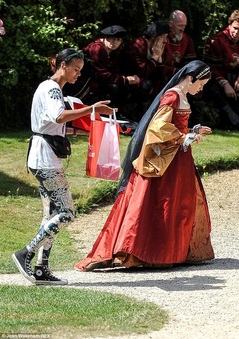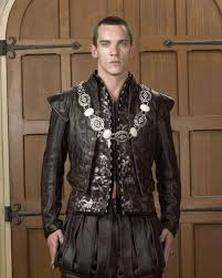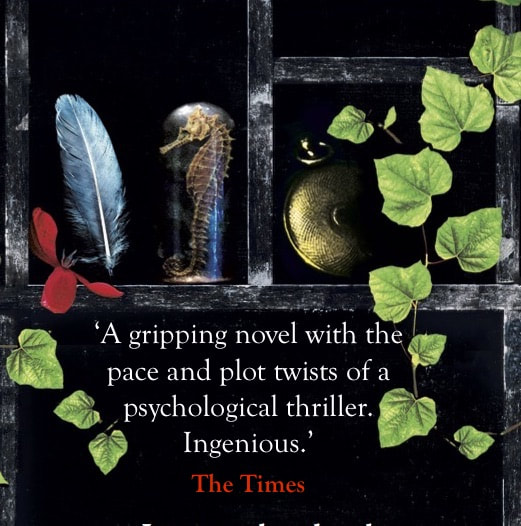 I visit many historic houses when researching my novels but occasionally a place seduces me completely. One of these was Bolsover Castle in Derbyshire. I had been on a research trip to Hardwick Hall as I’m writing about Arbella Stuart who spent much of her youth there. Hardwick creates an impression, its vast windows, its symmetry, its gallery stretching endlessly, all combine to for instant impact. I knew that Bolsover Castle was nearby and had been in the same family but didn’t fall in the compass of my research so had intended to give it a miss, particularly as I felt nothing could compete with the glamour of Hardwick, but I had a spare morning and so drove the short distance to Bolsover in the October drizzle. It was deserted and I wandered about alone entirely captivated. Like Hardwick Bolsover is perched on a promontory looking out over the Derbyshire countryside and Smythson, the architect of Hardwick was involved in its creation, as was his son, but there the similarities end. Bolsover has nothing of the grandeur and size of Hardwick but what it lacks in splendour is made up for in its abundance of charm. The older parts of the house, set in a long rambling curve of golden stone, blackened with age in places, have fallen into ruin, but the sense of how the spaces might have been lived in is easy to see. The riding house, built around 1660, with its viewing gallery, timber beams and sand floor, still stands. It was the pride of William Duke of Cavendish, whose dedication to the equestrian arts was unprecedented for an English nobleman of the period, making him the epitome of the cavalier. I plan to return for one of the costumed equestrian events that are held in the spring, to see the riding school in all its glory and used as it was intended. The jewel in the crown of Bolsover though, is the Little Castle, built by Charles Cavendish (father of William) between 1612 and 1617 is a castle in miniature and is entirely intact. It is surrounded by a circular wall with a walkway that offers a view of the both buildings and the rolling landscape beyond. The Little Castle’s interiors have a feeling of luxury that makes up for its diminutive size. The intricate fireplaces, vivid murals and painted panelling have all been carefully preserved and restored and lend the place an air of frivolity that is quite beguiling and at times a little decadent. The Marble Closet, a room lined in rich marble and adorned with risqué depictions of Venus, is clearly designed with a gentleman in mind. On walking through the rooms, the Heaven Closet, the Elysium Closet, the Star Chamber, each with its own particular character, Bolsover worked its enchantment on me, making me search for ways to put it in my fiction. Perhaps in my proposed novel about Charles I’s Queen, Henrietta Maria, I will be able to work in the 1634 royal visit to Bolsover for a feast and performance of Ben Jonson’s ‘Love’s Welcome.’ Otherwise it will have to be a book about Margaret Cavendish the wonderfully eccentric author and thinker who was the second wife of the William the cavalier duke. http://www.english-heritage.org.uk/daysout/properties/bolsover-castle/#Right
0 Comments
 Anne Boleyn plus PA (Daily Mail) Anne Boleyn plus PA (Daily Mail) The airing of Wolf Hall’s small screen cousin has provoked a good deal of discussion: is it too slow; is it too confusing; is it too dark; wasn’t Henry fatter; wasn’t Cromwell more of a monster; is it accurate? The question of historical truth comes around again and again. The Imitation Game ruffled feathers for, amongst other things depicting Turing as possibly involved in (or knew about and turned a blind eye to) treachery when there is not a shred of evidence to suggest that this might have been the case. People have complained that there wasn’t enough science in The Theory of Everything, without stopping to think that the film is an adaptation of Jane Hawking’s book – it is her version of events not his. Mike Leigh’s Mr Turner provoked tumultuous critical delight over Timothy Spall’s snorting, grunting performance, which I personally found grotesquely over-played. ‘But he was supposed to be just like that,’ people cried in response to my criticism. ‘Based on what exactly?’ I asked. We can get so wrapped up in the idea of accuracy that it is easy to forget such a thing is impossible. With Wolf Hall it’s all been about the authenticity, with costume designers talking about how they only used fabrics of the period and correct fastenings – mostly pins, in case you were wondering and not zips, which was the accusation levelled (hotly denied, I might add) at the recent White Queen adaptation. But, I ask myself are they all going commando because as all self-respecting Tudorphiles will know, knickers hadn’t been invented in the sixteenth century. The ‘authentic’ lighting (mainly candlelight for interiors and nothing outside) has meant a good deal of viewers grumbling about not being able to see anything. ‘Ah but that is how it would have been,’ come the replies. That may be so but to our twenty-first century eyes, used to the brightness of the present, our response to it is jarring and confusing. A Tudor would not have responded in such a way; it would have been the norm, their eyes would have been accustomed to a dimmer world, more in tune with the seasons and fluctuating hours of daylight. What I’m trying to get at is that absolute authenticity remains out of reach, like Plato’s perfect forms, and to try so hard at it can be a futile project. I like the gloom of Wolf Hall, not because of its historical veracity, but mainly because it works with the shadiness of its protagonist, though unfortunately in some of the exterior scenes, shot in the gloaming it looks, on my brand new super-duper-HD TV, rather than atmospherically shadowy, depressingly redolent of low-tech BBC costume drama from the 1970s. But I sympathise with the intention even if the outcome is not necessarily wholly successful because I find myself noticing other things, like the puzzling absence of mud in the exterior scenes and the perfectly manicured gravel driveways and the dog that looked suspiciously like a cockapoo and Anne pronouncing his name Purcoy phonetically rather than the French way (Pur-cwa) as she would have done. Now I'm just being a pedant and the point I'm trying to make is that none of it really matters; what matters is the effect it has. Then of course there’s the question of Cromwell and his character. Views on this are polarised. A historian friend believes Mantel’s Cromwell is too modern in sensibility. It seems to be Mantel’s project to explore the possibility that Cromwell was a remarkable self-made man, and yes, darkly complex and Machiavellian but not just, to borrow Dairmud MacCulloch’s term, ‘a thug in a doublet’; whereas revisionist historians seek to expose the Reformation, the promotion of which was Cromwell’s life’s work, as an act of monstrous destruction akin to the acts of fundamentalists in North Africa today. We will never find a definitive truth but what is good is that texts such as Wolf Hall open up discussion. What a TV show like Wolf Hall is attempting to do is to set itself above the usual costume drama. It’s narrative is convoluted, it refuses to spoon feed us, makes us work hard, makes us think. It says ‘I am authentic,’ suggesting that Jonathan Ryhs Meyers in his hopelessly anachronistic, yet very fetching, faux-Tudor gear, is not – I couldn’t possibly comment. But when we watch TV we know that only a few feet away is a fellow with a big camera and that we’ve seen these actors in other roles, that they’re all pretending. We want to suspend our disbelief, we’re in on the sleight of hand, and do we care if they are wearing knickers? I suspect not. |
Subscribe to Elizabeth's quarterly newsletter below:Archives
June 2018
Categories
All
|










 RSS Feed
RSS Feed
